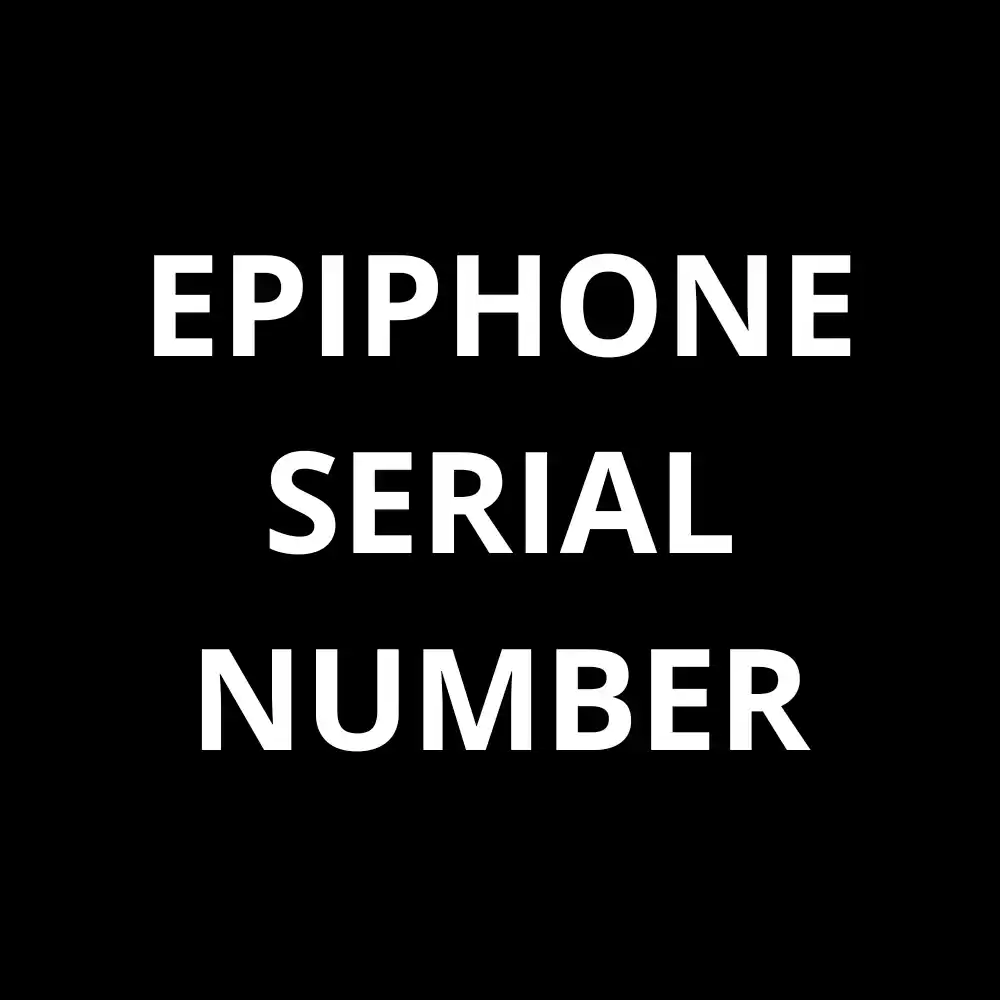How To Date My Epiphone? Find The Serial Number
Epiphone guitars are manufactured in various factories across different countries, making it challenging to identify their origin or manufacturing date. However, each guitar is marked with a serial number that, once decoded, can reveal details about Epiphone‘s date and location.
Table of Contents
How To Find Epiphone Serial Number?
Epiphone serial number usually contains a combination of digits and 1 or 2 letters. The stamped serial number can consist of a series of digits, or letter(s) + digits.
To find the serial number, look up it on the headstock. For Semi-Hollow guitars, the serial number can be found on the label inside the top f-hole, while for acoustic guitars, it can be detected on the label inside the sound hole.
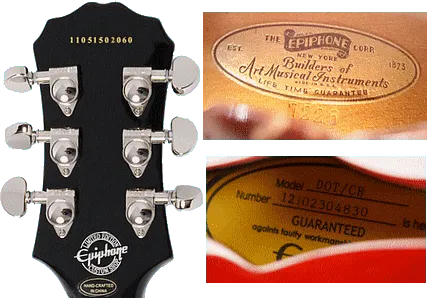
Epiphone Serial Number With Only Digits
11 Digits Serial Number
For example let’s check the Epiphone serial number: 11051500160.
The first two digits are the last 2 digits of the year (11).
The next two digits represent the month (05).
The 5th and 6th digits represent the factory code (15) (See list numbered factory codes).
The last 5 digits form the series sequence number.
So, serial number 11051500160 is the 160th guitar built in May 2011 at the factory of Qingdao in China.
Since 2004 Epiphone guitars have been produced in China.
5-digit Serial Number
Five digits with a space after the first digit and custom shop on the back of the headstock, applied from 1990 to 1999. The first digit is the last digit of the production year, the following four digits are the serial number. Five digits with no space after the first digit were used from 1951 to 1956 and from 1961 to 1967 for both acoustic and electric models.
6-digit Serial Number
From 1961 to early 1970, Epiphone used 6-digit serial numbers. However, many serial numbers were duplicated during this period, making the exact production year difficult to trace. The models with a 6-digit serial number starting with 0 were certainly produced in 1967.
7-digit Serial Number
7-digit serial numbers do not have a factory code. Here is the first digit of the last year of the decade. The 2nd and 3rd numbers represent the month. These were manufactured in Korea by Samick between 1984 and 1995.
8 and 9 Digit Serial Numbers
8 and 9 serial numbers are without a factory code. These were used respectively from 1990 and 1988 and also manufactured by Samick in Korea.
Epiphone Serial Number With Letters And Digits
Serial Number 1 letter 5 digits
This combination was applied to the Elite/Elitist models. The letter indicates the factory code and the first digit is the last digit of the year (since 2002). The factory code can be an F or a T here (See list Factory code letter).
Example: Serial number T32222 is the 2222th guitar of 2003 built in the factory of Terada Gakki Seisakusyo, Japan.
Serial Number 1 letter 6 digits
The letter indicates the factory code and the first and second digits are the last two digits of the year.
Example: Serial number Z051234 is the 1234th guitar built in 2005 at the Zaozhuang Saehan factory in China.
Between 2001 and 2010 only 1 digit was used for the production year.
Serial Number 2 letters 5 digits
The letters indicate the factory code and the first digit is the last digit of the year.
Example: Serial number CI21234 is the 1234th guitar built in 2002 at the Cort, Indonesia factory.
Serial Number 1 Letter 7 Digits
The letter indicates the factory code and the first digit is the last digit of the year. The 3rd and 4th digits represent the month. The last 4 digits form the series sequence number. Because the year is only represented by 1 digit, guitars with this coding from the 80s, 90s, or a decade of 2000 (depending on the factory code).
Example: Serial number S6031234 is the 1234th guitar built in 1986, 1996, or 2006, the month of March at the Samick factory in Korea.
Serial Number 2 letters 6 digits
The letter indicates the factory code and the next two digits are the last two digits of the year. The second letter (fourth character) stands for the month (A = January, B = February, etc.). The last 4 digits form the series sequence number.
Example: Serial number R04G0123 is the 123rd guitar of July 2004, built in the Peerless, Korea factory.
Serial Number 1 letter 8 digits
The letter indicates the factory code, and the next two digits are the last two digits of the year. The 3rd and 4th digits represent the month. The last 4 digits form the series sequence number.
Example: C99040233 is the 233rd guitar of April 1999, built in the Cort factory, Korea.
This coding method was used until 2010.
Serial Number 2 Letters 7 Digits
The letter indicates the factory code, the next 2 digits are the last 2 digits of the year. The second letter (fourth character) stands for the month (A = January, B = February, etc.). The last 5 digits form the series sequence number.
Example: S07C00122 is the 122nd guitar of March 2007, built at the Samick factory in Korea.
This coding method was used until 2010.
Serial Number 2 Letters 8 Digits
For example let’s check Epiphone serial number: SI02060234.
The first 2 letters indicate the factory code, and the next two digits are the last 2 digits of the year.
The 5th and 6th digits represent the month.
The last 4 digits form the series sequence number.
So, serial number SI02060234 is the 234th guitar of June 2002, built at the Samick factory in Cileungsi near Bogor, Indonesia.
Serial Number 2 letters 9 digits
This coding is the same as the coding of 2 letters 8 digits with the difference that here is 5 digits for it sequence number are used.
Epiphone factory codes digits Chart
| NUMBER | FACTORY | COUNTRY |
|---|---|---|
| 10 | unknown | China |
| 11 | Qingdao | China |
| 12 | DeaWon or Unsung | China |
| 13 | unknown | China |
| 14 | DaeWon | China |
| 15 | Qingdao (electric) | China |
| 16 | Qingdao (acoustic) | China |
| 17 | unknown | China |
| 18 | unknown | China |
| 19 | Fine Guitars | China |
| 20 | DeaWon or Unsung | China |
| 21 | Unsung | Korea |
| 22 | unknown | Korea |
| 23 | Samick | Indonesia |
Epiphone serial code letters Chart
| NUMBER | FACTORY | COUNTRY |
|---|---|---|
| B | Bohêmia Musico-Delicia | Czech Republic |
| BW | unknown | China |
| C | Cort | Korea |
| CI | Cort | Indonesia |
| DW | DaeWon | China |
| EA | Qingdao (acoustic) | China |
| ED | Dongbei | China |
| EE | QingDao (electric) | China |
| F | Fuji-gen (Elite/Elitist models) | Japan |
| F | Fine Guitars | Korea |
| FC | Fuji-gen (nineties) | Japan |
| G | QingDao (acoustic) | Korea |
| GG | unknown | Korea |
| GR | Farida, Guang Dong | Indonesia |
| I | Saein | Korea |
| IS | Samick, Bogor | Indonesia |
| J | Terada Gakki Seisakusyo | Japan |
| K | Korea Ins. | Korea |
| L | Leader Musical Instrument Co Ltd. | Korea |
| MC | Muse | China |
| MR | Mirr factory | China [Korea to 2004] |
| O | Choice | Korea |
| P | Peerless | Korea |
| R | Peerless | Korea |
| QG | Qingdao Gibson | China |
| S | Samick | Korea |
| SI | Samick, Bogor | Indonesia |
| SJ | SaeJun | China |
| SM | Samil | Korea |
| T | Terada Gakki Seisakusyo | Japan |
| U | Unsung | Korea |
| UC | Unsung China | China |
| Z | Zaozhuang Saehan | China |
Unclear Epiphone serial number factory code Chart
| NUMBER | FACTORY | COUNTRY |
|---|---|---|
| H | unknown | Probably Hunan, China |
| GP | unknown | Probably Korea |
| JK | unknown | Probably Korea or Indonesia |
| SK | unknown | unknown |
| SN | unknown | Probably Indonesia |
| SW | unknown | unknown |
| WF | unknown | Probably China |
| X | unknown | Probably China |
| Y | unknown | Probably Korea |
If you are unsure whether the serial number corresponds with the year of manufacture, you can do a potentiometer check with an electric model.
Dating Epiphone Acoustic Guitars
Epiphone Japanese Guitars
The acoustic guitars from Epiphone, which were manufactured by Matsumoku in Japan from 1970 to 1987, are not a reliable serial numbering system but can be approximately dated by color and inscription from the Epiphone label.
Epiphone Blue Label.
The first blue labels that were used were leftover labels from the Kalamazoo factory. In the bottom left corner of these labels is printed “Union Made” and stamped, “Made in Japan”. Until supplies ran out, they were used from 1970 until the beginning of 1971. Some of these first labels do not include Made in Japan or Union Made. After supplies ran out, new blue labels were used where in the lower right corner “Made in Japan” is printed.

Epiphone Label Brown or White “Lincolnwood”.
Brown “Lincolnwood” label was used from 1976 to 1979.
The Lincolnwood label was also used for the acoustic guitars of the Taiwanese “Ep” series from 1979–1980. These labels in the bottom right corner say, ‘Made in Taiwan’.

Epiphone Mottled Label.
From 1980 to 1987 a mottled pattern label was used for Japanese acoustic guitars.
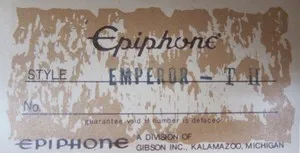
Epiphone Korean Guitars
The color of the Epiphone ‘made in Korea’ label makes it possible to identify the period in which the guitar was built.
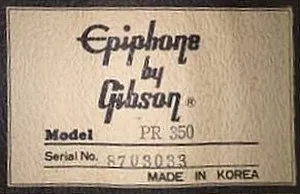
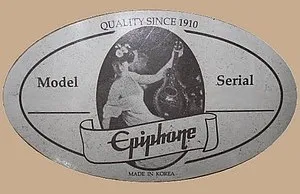
Epiphone Chinese Guitars
In 2004 a factory was opened in Qingdao, China, which produces Epiphone guitars. No labels have been used here, but stickers with “Made in China” are glued to the neck of the guitars. Except for the Masterbilts, these do have a label with a serial number in the resonance box.
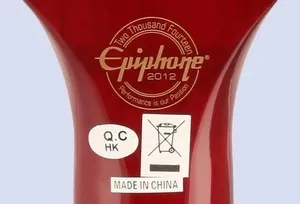
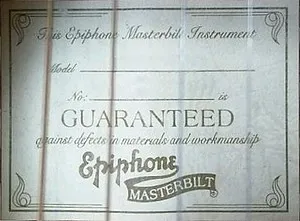
For extended search you can also
